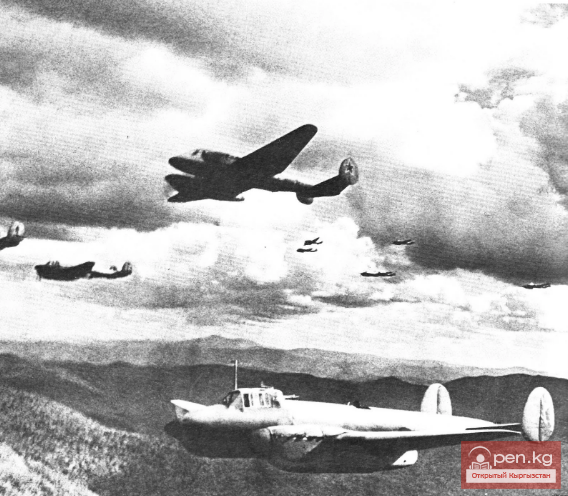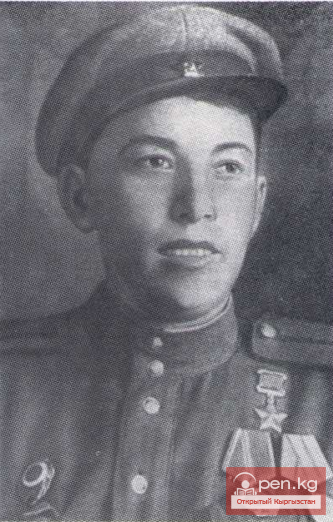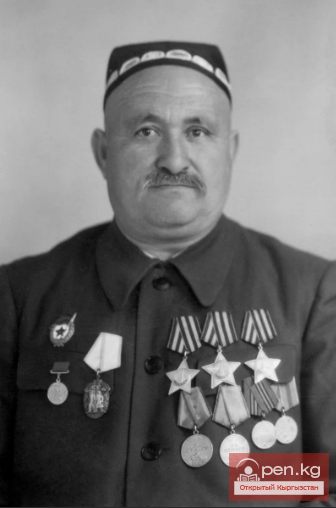
Hero of the Soviet Union Nikolai Prokofievich Miroshnichenko
Nikolai Prokofievich Miroshnichenko was born in 1920 in the village of Petrovskoye, Stavropol Krai. Since 1928, he lived in the village of Sadovoe in the Moscow District of the Kyrgyz SSR. He was Ukrainian. A member of the Communist Party of the Soviet Union (CPSU). In 1940, he was accepted into the Saratov School of Pilots, and later studied at the Chkalov Military Aviation School, the period of which coincided with the beginning of the Great Patriotic War. He was a Guards Senior Lieutenant and squadron commander.
He participated in battles starting in June 1942 as part of the troops of the Leningrad and 3rd Belorussian Fronts. An excellent pilot, he mastered piloting techniques perfectly. During combat operations on the "PE-2" aircraft, he made 160 successful sorties.
For his successes in the fight against the German-fascist invaders, demonstrated bravery, courage, and heroism, he was awarded the title of Hero of the Soviet Union by the Decree of the Presidium of the Supreme Soviet of the USSR on June 29, 1945.
While carrying out another command assignment, Senior Lieutenant N.P. Miroshnichenko was killed on May 5, 1945.
Eternally Among Us
Nikolai Miroshnichenko heard the terrible news of the treacherous attack by fascist Germany on our country while he was studying at the Saratov School of Pilots. He was 21 years old at the time.
In 1940, when the young man from the village of Sadovoe left for Saratov to study, his fellow villagers were quite proud that they would have their own pilot among other specialists in the village. Little did Nikolai know that he would not return to his native places, nor would he enjoy the wide fields beyond the outskirts or the hay meadows.
A year after the war began, Nikolai Miroshnichenko, having completed the Chkalov Military Aviation School, began his military biography as the commander of the squadron of the Red Banner, Order of Kutuzov 34th Tikhvin Bomber Aviation Regiment of the Leningrad Front. In war, as in war. The front does not forgive mistakes, especially in the air, where the slightest error or delay can result in the death of the entire crew and the loss of the combat aircraft. Here, in combat conditions, the theoretical knowledge acquired in school was tested. Each sortie beyond the front line was an exam of maturity, requiring timely and accurate decisions. How many times he miraculously escaped from pursuing German fighters.
The squadron of Senior Lieutenant Miroshnichenko carried out numerous bombing strikes on the enemy's defensive lines in the Lobanova area. On July 25, 1943, the fascists launched a bridge over the Mga River, which had strategic significance for them. On the same day, a successful bombing destroyed an enemy artillery battery.
Typically, bombers fly under the cover of fighters, but there were flights without cover. Here, everything depends on the skill of the commander. Otherwise, a multi-ton bomber can become easy prey for enemy fighters. Nikolai often flew on bombing missions without cover.
Especially successful for Miroshnichenko were solo reconnaissance flights. Starting in June 1943, the brave guardsman made up to forty solo sorties, scouting the movement of fascist troops, the delivery of ammunition to the front line, and the concentration of enemy manpower and fortifications. As a result, he delivered valuable intelligence data, based on which our command planned upcoming combat operations.
Summer 1943 arrived, marking a turning point in the Great Patriotic War.
Enemy aviation no longer dominated the skies as it had at the beginning of the war. The Nazis were suffering serious defeats everywhere. Soviet aviation no longer allowed the fascists to bomb besieged Leningrad with impunity.

On June 9, 1943, a group of nine Soviet bombers "PE-2" under the command of Senior Lieutenant N. Miroshnichenko took off on a combat mission. The objective was to bomb and destroy the enemy airfield near the village of Siverskaya. As they approached the target, the fascists opened heavy anti-aircraft fire. Nevertheless, the "Pe-2s" completed the mission, destroying fuel and bomb depots, and setting fire to 15 fascist aircraft. The squadron returned to its airfield without losses.
On one of the July days in 1943, the squadron was tasked with reconnoitering the enemy's defensive lines, manpower, and equipment in the settlements of Krasnogvardeysk, Siverskaya, Vladimirovskaya, Novo-Lisino, Tosno, and Voitolovo. The pilots flew three reconnaissance sorties until they completely identified the necessary targets and completed the combat mission.
The first flight went smoothly. They took off without cover, and the fascist fighters did not engage.
Nikolai, in his "Pe-2," scoured the points of Krasnogvardeysk and Siverskaya. After a short break, the crew took to the air again. The fascists greeted the aircraft with anti-aircraft fire, but to no avail. The "PE-2" quickly slipped through the combat barrier and continued reconnaissance.
When the bomber flew for the third time to the specified points, the sun was already setting. This time, the fascists' anti-aircraft fire was stronger, and shells exploded almost near the aircraft. But the crew skillfully maneuvered and managed to slip through the anti-aircraft fire zone once again. Fortunately, enemy fighters did not appear on their path.
The crew completed the command's assignment.
Five days after these bold and risky sorties, Senior Lieutenant Miroshnichenko was awarded his first combat decoration — the Order of the Red Banner. Three months later, another combat order — the Order of the Patriotic War I class — shone on the chest of the brave commander.
The soldiers of the sky served the cause of victory over the hated enemy splendidly. Our bombers destroyed and eliminated long-range batteries of the fascists that shelled Leningrad; their bombing raids burned many enemy convoys, ammunition depots, and fuel supplies. Hundreds of Nazis fell victim to the squadron's attacks. Bombers under the command of our compatriot Nikolai Miroshnichenko actively participated in the liberation of Karelia,
Soviet Estonia, and in the defeat of the enemy's Courland group.
For many months, a long-range battery of the fascists installed in the Pavkul area did not give the Leningraders any peace. Shelling it with our ground and naval artillery did not yield the desired results. The guns of the armored trains did not reach the target. Therefore, the command set a task for our bombers: to destroy the enemy's long-range battery in a short time.
And so, on a September morning in 1943, Miroshnichenko's squadron took to the air. As our planes began to dive on the target, the fascists opened chaotic anti-aircraft and machine-gun fire. One by one, the bombers dove in, and the battery was destroyed. Thus, our compatriot, Guards Senior Lieutenant Miroshnichenko, made a significant contribution to the heroic defense of the city of Lenin.

In the early days of April 1944, the squadron received the task of bombing enemy convoys at the Tartu station and airfield. Everyone understood that the task was difficult, as the fascists had taken care to guard these important objects from the air. A tense combat day lay ahead.
At noon, with powerful engines roaring, eight "PE-2" bombers rose into the blue sky. As they approached the railway station, enemy fighters appeared ahead and from the side. The fascists were ready.
— Up to thirty fighters, — came the message over the radio.
— No panic. The main thing is the target, the convoys, the station. Do not let the fighters get close, meet them with onboard fire, — calmly and clearly commanded Miroshnichenko to his pilots.
The battle heated up. Fascist "Messerschmitts" and "Focke-Wulfs" attacked our bombers from all sides, trying to disrupt precise bombing. Suddenly, the red-star aircraft flying on the left began to smoke...
But the "Pe-2s" stubbornly continued towards the target. It was very close. One after another, our bombers began to dive on the station. Miroshnichenko's aircraft entered the dive. For a few seconds, the railway station and the standing convoys on the tracks were covered with explosions. Suddenly, from the right, a "Messerschmitt" rushed towards the bomber. The radio operator-gunner caught it in his sights and pressed the trigger of the onboard machine gun: hit! The "Messerschmitt" began to smoke and tumbled down. But it was too early to rejoice. Now, a fascist fighter came in from the left and riddled the bomber with a burst of machine-gun fire. A sharp pain pierced Nikolai's leg.
He had been hit by a fragmentary bullet. "I must make it back to my own!" — flashed through the commander's mind.
Having dropped all bombs on the target, Nikolai turned the aircraft around and flew back towards the front line, to his airfield. Others followed him. "Just don't lose consciousness," — he thought, gripping the control stick tightly. Meanwhile, the squadron crossed the front line. The "Messerschmitts" turned back in unison. Only when the aircraft touched down on the runway of the native airfield and came to a stop did Nikolai lose consciousness.
After the hospital, the brave pilot flew out to smash the fascists many more times. On January 20, 1945, N.P. Miroshnichenko led his squadron twice to bomb major hubs — the cities of Istenburg and Gumbinnen. Accurate bomb hits in Istenburg destroyed 60 meters of railway track. In the city of Gumbinnen, despite heavy enemy anti-aircraft fire and the close proximity of our ground forces to the bombing targets, an ammunition depot was blown up, 75 meters of railway track was destroyed, and direct hits were recorded on the dam. On May 5, 1945, during another combat sortie, Senior Lieutenant Miroshnichenko did not return...
Already after the victory over fascist Germany, a decree from the Presidium of the Supreme Soviet of the USSR was issued, awarding the brave pilot Nikolai Prokofievich Miroshnichenko the high title of Hero of the Soviet Union.
Yes, yes, we are not mistaken, not posthumously, but simply awarded. This is deeply symbolic. Kolya Miroshnichenko is among us.
S. CHERIKOV















































